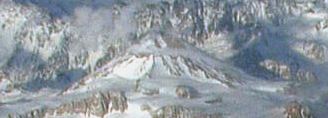Palomo facts for kids
Quick facts for kids Palomo |
|
|---|---|

Palomo volcano
|
|
| Highest point | |
| Elevation | 4,860 m (15,940 ft) |
| Geography | |
| Location | Chile |
| Parent range | Andes |
| Geology | |
| Mountain type | Stratovolcano |
Palomo is a tall volcano in Chile. Its name means "dove" in Spanish, which comes from the shape of its glaciers. This volcano stands about 4,860 meters (15,945 feet) high. It is located in the Machali area, in the Cachapoal province. Palomo is one of only two volcanoes in its region that shows signs of erupting in the last 11,700 years. Because it is in a remote area, scientists are still learning a lot about its geology and possible dangers.
Contents
About Palomo Volcano
Palomo is a type of volcano called a stratovolcano. This means it is built up over time by many layers of hardened lava, ash, and rocks. The volcano has an irregular shape. Scientists estimate its size to be around 9.2 cubic kilometers. Palomo rises from an elevation of about 3,215 meters (10,548 feet). It covers an area of about 22.4 square kilometers (8.6 square miles).
Craters and Nearby Vents
Underneath the main volcano, there are two large bowl-shaped areas called calderas. These are about 3 kilometers (1.9 miles) and 5 kilometers (3.1 miles) wide. The top of Palomo also has two craters. This might mean that the volcanic activity has slowly moved towards the northeast over time.
About 4.5 kilometers (2.8 miles) northeast of Palomo is a smaller, separate vent called Andrés. This vent is about 3,300 meters (10,827 feet) high. Andrés has a crater that is about 500 meters (1,640 feet) wide and opens to the south. It sits on a base of older, hard rock. The name Andrés was given by a geologist named Reynaldo Charrier, who hoped his son, Andrés, would also explore the mountains one day.
Location on a Fault Line
Both Palomo and Andrés are located on a large crack in the Earth's crust called the El Diablo fault. Many other volcanoes and hot springs are found along this fault line. This fault separates different types of rock formations that formed millions of years ago.
Glaciers and Rivers
Palomo volcano is surrounded by large glaciers. These glaciers are important because they feed several rivers.
Northern Glaciers
On the northern side of the volcano, several large glaciers form the Rio Blanco, Rio Cortaderal, and Rio de los Cipreses rivers. These rivers all flow into the Cachapoal River. In 1847, a hot event at the volcano caused some ice to melt quickly. This led to a large flood in the Cachapoal River.
Southern Glaciers
On the southern side, there is a large glacier called the Universidad Glacier. It is about 10 kilometers (6.2 miles) long. This glacier forms the Rio San Andrés, which flows into the Tinguiririca River. In 1958, the Universidad Glacier was the second longest glacier in Central Chile. However, like many glaciers in the region, it has shrunk since then. The line where snow stays all year round is between 3,100 and 3,300 meters (10,170 and 10,827 feet) high.
Volcanic Rocks
The main part of Palomo volcano is mostly made of hardened lava flows. These lava flows cover parts of the older calderas at the base of the volcano. Palomo has erupted different types of lava, including andesite, dacite, and basaltic andesite. These are all types of volcanic rocks that are common in volcanoes like Palomo.
The rocks from the main volcano have many visible crystals called phenocrysts. Most of these crystals are plagioclase, which is a type of mineral. Other minerals like clinopyroxene and orthopyroxene are also present but in smaller amounts. The rocks from the Andrés vent are a bit different. They have more amphibole and olivine minerals, and less plagioclase than the main volcano's rocks.
History of Eruptions
Scientists use a method called Argon–argon dating to find out how old the rocks from Palomo are. Rocks from the main summit are about 100,000 years old. Lava flows from Andrés, which formed after the last ice age, are about 40,000 years old. However, volcanic activity at Palomo might have continued even more recently, possibly into times before Europeans arrived in the Americas.
As mentioned, a flood happened in the Cachapoal Valley in 1847. This flood might have been caused by a hot event on Palomo volcano that melted a lot of ice. If Palomo erupts again in the future, it could cause mudflows called lahars. These lahars would happen if the heat from the volcano melted a lot of ice and snow. Such mudflows could affect the valleys of the rivers that flow from the volcano.
See also
 In Spanish: Cerro El Palomo para niños
In Spanish: Cerro El Palomo para niños
- List of volcanoes in Chile
- List of mountains in the Andes

